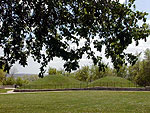By Dan Olson
Minnesota Public Radio
May 27, 2002
Memorial Day draws visitors to carefully tended modern day cemeteries. All around Minnesota there are hundreds of ancient cemeteries, many unmarked and untended. Even so, many, including state archaeologists, consider them sacred ground. Many have been identified. Federal law protects them. One of the state's best known ancient burial sites is in St. Paul, high above the Mississippi River.
| |
|
|
|
||
The view from Indian Mounds Park in St. Paul is simply remarkable. Neighborhood resident George Smolik, out for a bit of air on a fine spring afternoon, stands on the bluff overlooking the Mississippi River as it flows south.
"The land, the flowers, the trees, I think it's one of the most beautiful places I've ever been," he says.
The commanding view from Indian Mounds park is due to its location high atop a bluff far above above the Mississippi River.
Two-thousand years ago or so others, attracted by the view, began building earthworks here - burial mounds. The 20-foot-high mounds are about the size of a small house. They're covered with a verdant spring growth of calf-high, emerald green grass. The mounds are gently sloped. You could walk up them, but a sign asks visitors to respect the area.
State Archaeologist Mark Dudzik says this is sacred ground. When they were looted a hundred years ago by curious seekers the mounds supplied unmistakable evidence they are sacred. "Human remains and grave goods which could include pottery or exotic shell, or caches of projectiles, copper tools, a wide variety of items," he says.
| |
|
|
|
||
At his Fort Snelling office a few miles upriver from Indian Mounds Park, Dudzik supplies a dramatic illustration how much importance early peoples attached to building mounds with a commanding view. He brings up on his oversized computer screen a map of Minnesota but absent the distinctive v-shaped course of the Minnesota River as it cuts through southern Minnesota. However, a string of red dots, each representing a cluster of mounds, marks the river's course.
"You see here a line in red and that indicates the bluff line above the Minnesota river along its course and yet the river is not demarcated on the map, what you've got is many mounds are built to take advantage of a vista," he says.
Many of Minnesota's mounds, Dudzik says, are hundreds of years old. The Indian Mounds in St. Paul were started, he says, 1,000 years ago.
"That site was probably occupied on and off throughout that period, and the mounds weren't built as we build housing developments this year, they were built over time by a succession of peoples," according to Dudzik.
| |
|
|
|
||
Lost, Dudzik says, are petroglyphs near the Indian Mounds in St. Paul. The bluff area above the river is laced with caves. Early white visitors recorded their amazement at finding intricate carvings of animals and other figures.
"Of course the rock art in this area was made of sandstone and was heavily visited early on even in the late 1800s was found to have much graffiti and has regrettably passed away," he says.
Federal law prohibits tampering with burial sites more than 50 years old. A year and a half ago Minnesota began returning to American Indians in the state funerary items taken over the years from burial mounds.
More Information


